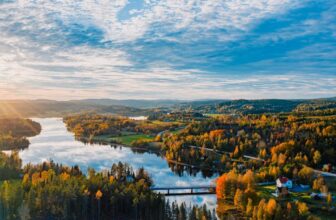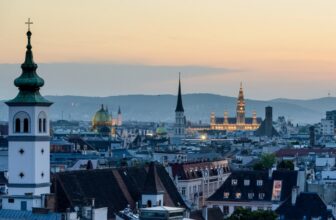Nestled in southern Central Europe, sitting at the feet of the Eastern Alps mountain range, is the picturesque land of Austria. Although a landlocked country, Austria is as magnetic as its famed neighbors.
With Germany to the northwest, Italy to the south, Hungary to the east, and beautiful Switzerland to the west, you will never be bored here with so many prestigious neighbors so close by. There are mountains to behold, castles and monuments to explore, and beautiful cities to traverse throughout this nation.
But before you run to your nearest airport with a ticket in hand, there are a few things to consider to ensure your vacation is hassle-free. Grey skies, pricey hotels, and lengthy queues are enough to put most off a trip abroad, but thankfully these things can be maneuvered around.
So, here are a few things to consider to ensure that you arrive at the best time to travel to Austria.
When is the Best Time of the Year to Visit Austria?
The seasons in Austria can oftentimes stand as their own attractions to visitors. The weather can vary between regions, given the terrain which is a collection of some major and minor mountain ranges, hills, and flatlands with varying altitudes.
Overall, the rainfall in the area is moderate with a yearly rainfall of about 40 inches. In the lower regions, you can find a more continental climate with warm summers and cool winters. You can find warmer temperatures of about 86°F (30°C) in the southern areas, and it can get a lot wetter the further west you go.
Although the weather also varies according to altitude, the different conditions allow for many flora and fauna to flourish across the country. This also means that with each season comes a diverse landscape to explore and scenery to appreciate. The fall colors are especially dazzling.
Thankfully, you will not be too pressed for time trying to see it all. You can visit most of Austria’s gems within a week’s stay, but this does not mean that you shouldn’t try to stay longer to really relish the magic. Especially if you find yourself part of the tourist crowd.
Visit Austria in Spring
March through to May is known as Austria’s shoulder season, as it falls just outside of the peak season. Here, temperatures can cool to a comfortable 54°F (12°C), tourist activity is reduced, and prices are more affordable and negotiable.
April and May are great for Austrian sightseeing, although several public holidays could reduce your opportunities due to closures. Thankfully, these holidays also provide a slew of festivities to partake in to compensate for the closures.
There is the Osterfestspiele Salzburg (Salzburg Easter Music Festival) from 1 – 10 April that highlights the country’s historical and classical musical spirit. One of the better ways to take in Mozart’s homeland. In Vienna, you can look forward to the Wiener Festwochen (Festival of Music and Art) in May to revel in some of Austria’s finest multidisciplinary artists and creations.
Spring is also suitable for outdoor activities where you want to avoid extreme weather conditions. Biking, hiking, and watersports are a riot in the spring, and the views are spectacular with snow still lingering on the mountains.
Warning: April is oftentimes one of the wettest months of the year, and the amount of rain will get denser the higher the region’s altitude, reaching over 700 inches in the Alps. Make sure you pack for rainy weather. It might not be freezing, but it’s best to stay dry as you peruse through the country.
Austria in the Summer
Summers in Austria is your best bet for warm, clear weather. In some regions, the temperature can reach as high as 86°F (30°C), but it will usually get cooler as the day wanes into the evening. This creates perfect conditions for those who thrive outdoors and do not mind the heat.
The hot months of June, July, and August are perfect for hiking through the countryside and taking in the full expanse of Austria’s greenery. And, although there isn’t a coast to offer any beach action, there is the gorgeous Hallstätter See (or lake) for your swimming leisure.
Here, you can take a boat tour across the lake’s expanse and catch a glimpse of the Grub Castle on the shore or rent one of the rowboats to scout the waters yourself. There are also bicycles to rent for those without their sea legs; the pathways along the shores are just as captivating!
These activities are also offered across the country, although you will miss the snow-capped allure of the Alps on the mountain trail routes. But there are many tours in the city to choose from, and the many attractions are spectacular under the summer sun. But you should mind the foot traffic.
Unfortunately, from June through to August is Austria’s peak tourist season. This means that prices are usually higher and crowds are denser, so expect your budget and time to be stretched somewhat.
Quick Tip: A tour of the historic Nazi conference venue on the summit of Kehlstein Mountain is only available in summer. This Eagle’s Nest tour from Salzburg is the perfect opportunity to take in the Bavarian and Austrian Alps.
Visiting Austria in the Fall
For a chilly three months, the Austrian countryside is awash in spectacular colors of browns, reds, and oranges. As the weather winds down in the early days of September through to November, Austria transforms, with temperatures at 26°F (-3°C), into a different magic. Snow starts to settle on the Alps, tourists leave with the incoming chill, and the festivities begin.
Not only will accommodation and travel be more affordable in the fall, but most attractions will still be open and welcoming visitors. There are many wine and harvest festivals to attend as well, like the Vienna Wine Hiking Day which is usually in late September.
Thankfully, the Austrian weather in September and early October is the driest of the year, so you can still explore the city with only minimal caution against gray skies. This is also a great time to try some outdoor activities if you want to keep warm.
If that’s not your style, then try getting acquainted with the country’s variation of Schnapps, a type of fruit brandy that will certainly keep you warm.

You Might Like: Tickets to the Hofburg Palace in Vienna, a feat of grandeur that has been standing since 1463. The palace is open daily and operates from 9 am to 5:30 pm from September to June.
The Chillest Time in Austria, Winter
You might not have easy access to some attractions as the weather becomes snowy, but there is no better time to experience a White Christmas. Temperatures can get to a low of 14°F (-10°C), which is not such a terrible price to pay when Austria looks like a giant snow globe for three months.
Part of the allure are the numerous Christmas markets that pop up in late November to December. But the true attraction that stretches well into January is the winter sports.
The Alps are snow-capped and ripe for those who cannot resist the thrill of skiing, snowboarding, or even ski-jumping. The city of Innsbruck in particular is a popular skiing destination. Read here to learn more about the resorts in the area.
For the romantics, Vienna is known as the city of waltzes, and it comes alive in the winter. Its annual ball season reaches a fever pitch between January and February. There are over 2,000 hours of dancing to partake in balls that are hosted across the city.
There is also no better time to rent a log cabin and soak up the fantasy of the winter and the view. You certainly won’t find a better destination for cuddle season.
Quick Tip: Austria is quite multi-ethnic with a large expatriate community. Although you will find some English speakers, the primary spoken language is German, specifically the Bavarian-Austrian dialect. Remember that there is no such thing as the ‘Austrian’ language.
Final Thoughts: When is the Best Time to Go to Austria?
Austria is an ever-changing jewel that holds a little something sweet for everyone. Its landlocked status should not deter anyone. This small part of Europe is rich enough to ensnare even the hardest of hearts. The specifics of that little sweet something are entirely up to you.
If you’re looking for an itinerary chock-full of sightseeing and activities and a well-earned tan, the peak summer seasons are for you. But if crowds and heightened prices are not your forte, then the spring and fall shoulder seasons would be better for you.
For those who crave the thrills and chills, winter is your Austrian wonderland. Your blood will certainly be pumping when you behold just how thrilling Austria can be from atop the Alps.
Whatever the reason for whichever season, make sure you don’t miss out on the opportunity to see the beauty for yourself.














